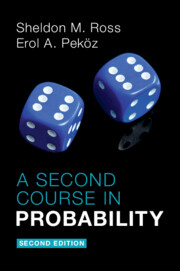Refine search
Actions for selected content:
52379 results in Statistics and Probability
Atypical diarrhoeagenic Escherichia coli in milk related to a large foodborne outbreak
-
- Journal:
- Epidemiology & Infection / Volume 151 / 2023
- Published online by Cambridge University Press:
- 11 September 2023, e150
-
- Article
-
- You have access
- Open access
- HTML
- Export citation
Seroprevalence of SARS-CoV-2 antibodies in Republic of Congo, February 2022
-
- Journal:
- Epidemiology & Infection / Volume 151 / 2023
- Published online by Cambridge University Press:
- 11 September 2023, e162
-
- Article
-
- You have access
- Open access
- HTML
- Export citation
The correlation between humoral immune responses and severity of clinical symptoms in COVID-19 patients
-
- Journal:
- Epidemiology & Infection / Volume 151 / 2023
- Published online by Cambridge University Press:
- 11 September 2023, e158
-
- Article
-
- You have access
- Open access
- HTML
- Export citation
VALID HETEROSKEDASTICITY ROBUST TESTING
-
- Journal:
- Econometric Theory / Volume 41 / Issue 2 / April 2025
- Published online by Cambridge University Press:
- 11 September 2023, pp. 249-301
-
- Article
-
- You have access
- Open access
- Export citation
On the size of maximal intersecting families
- Part of
-
- Journal:
- Combinatorics, Probability and Computing / Volume 33 / Issue 1 / January 2024
- Published online by Cambridge University Press:
- 08 September 2023, pp. 32-49
-
- Article
- Export citation

A Second Course in Probability
-
- Published online:
- 07 September 2023
- Print publication:
- 21 September 2023
7 - Robust Supervised Learning
-
- Book:
- Algorithmic High-Dimensional Robust Statistics
- Published online:
- 24 August 2023
- Print publication:
- 07 September 2023, pp 204-228
-
- Chapter
- Export citation
6 - Robust Estimation via Higher Moments
-
- Book:
- Algorithmic High-Dimensional Robust Statistics
- Published online:
- 24 August 2023
- Print publication:
- 07 September 2023, pp 166-203
-
- Chapter
- Export citation
2 - Efficient High-Dimensional Robust Mean Estimation
-
- Book:
- Algorithmic High-Dimensional Robust Statistics
- Published online:
- 24 August 2023
- Print publication:
- 07 September 2023, pp 29-60
-
- Chapter
- Export citation
Viable Clostridium botulinum spores not detected in the household dust of major Canadian cities
-
- Journal:
- Epidemiology & Infection / Volume 151 / 2023
- Published online by Cambridge University Press:
- 07 September 2023, e154
-
- Article
-
- You have access
- Open access
- HTML
- Export citation
Preface
-
- Book:
- Algorithmic High-Dimensional Robust Statistics
- Published online:
- 24 August 2023
- Print publication:
- 07 September 2023, pp xi-xiv
-
- Chapter
- Export citation
A 24-year longitudinal study of Klebsiella pneumoniae isolated from patients with bacteraemia and urinary tract infections reveals the association between capsular serotypes, antibiotic resistance, and virulence gene distribution
-
- Journal:
- Epidemiology & Infection / Volume 151 / 2023
- Published online by Cambridge University Press:
- 07 September 2023, e155
-
- Article
-
- You have access
- Open access
- HTML
- Export citation
Notation
-
- Book:
- Algorithmic High-Dimensional Robust Statistics
- Published online:
- 24 August 2023
- Print publication:
- 07 September 2023, pp xv-xvi
-
- Chapter
- Export citation
1 - Introduction to Robust Statistics
-
- Book:
- Algorithmic High-Dimensional Robust Statistics
- Published online:
- 24 August 2023
- Print publication:
- 07 September 2023, pp 1-28
-
- Chapter
- Export citation
3 - Algorithmic Refinements in Robust Mean Estimation
-
- Book:
- Algorithmic High-Dimensional Robust Statistics
- Published online:
- 24 August 2023
- Print publication:
- 07 September 2023, pp 61-99
-
- Chapter
- Export citation
5 - List-Decodable Learning
-
- Book:
- Algorithmic High-Dimensional Robust Statistics
- Published online:
- 24 August 2023
- Print publication:
- 07 September 2023, pp 119-165
-
- Chapter
- Export citation
Appendix - Mathematical Background
-
- Book:
- Algorithmic High-Dimensional Robust Statistics
- Published online:
- 24 August 2023
- Print publication:
- 07 September 2023, pp 265-270
-
- Chapter
- Export citation
Contents
-
- Book:
- Algorithmic High-Dimensional Robust Statistics
- Published online:
- 24 August 2023
- Print publication:
- 07 September 2023, pp vii-x
-
- Chapter
- Export citation
Dedication
-
- Book:
- Algorithmic High-Dimensional Robust Statistics
- Published online:
- 24 August 2023
- Print publication:
- 07 September 2023, pp v-vi
-
- Chapter
- Export citation
Zoonotic pathogens identified in rodents and shrews from four provinces, China, 2015–2022
-
- Journal:
- Epidemiology & Infection / Volume 151 / 2023
- Published online by Cambridge University Press:
- 07 September 2023, e174
-
- Article
-
- You have access
- Open access
- HTML
- Export citation


